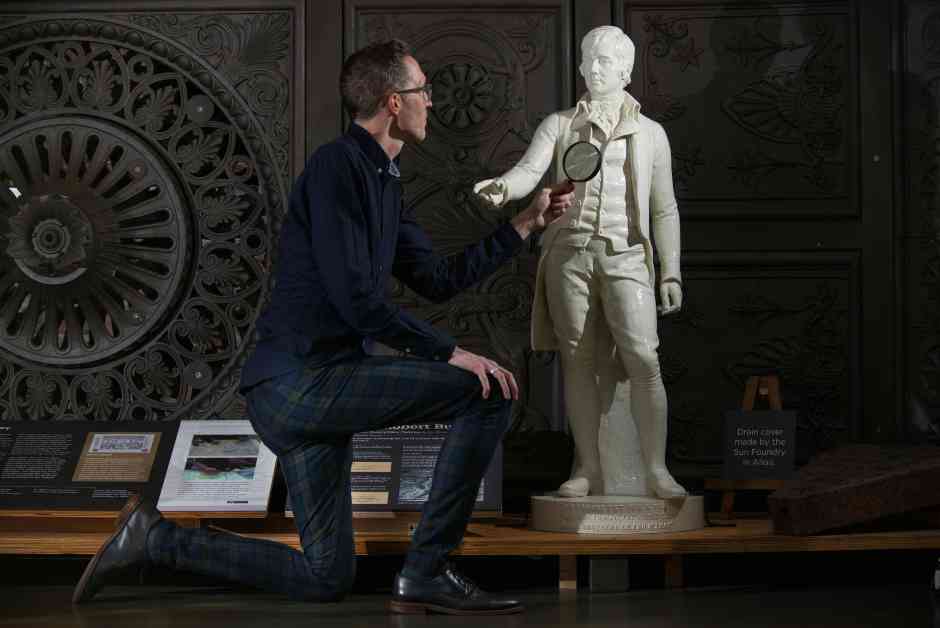A rare and historically significant cast-iron statue of Robert Burns has found a new home in Stirling, Scotland, after being discovered in a compost heap in Durban, South Africa, in the 1950s. The statue, known as ‘Rusty Rabbie,’ is one of the few surviving examples of its type and dates back to before the First World War. Designed by sculptor David Watson Stevenson and cast at McFarlane’s Foundry in Saracen, Glasgow, the statue was lovingly restored by Paul and Alexandra Morris, who have now donated it to Historic Environment Scotland.
Restoration efforts on ‘Rusty Rabbie’ included lead testing on flakes of paint to determine the original color, which has since been recreated to reflect the statue’s appearance when it left McFarlane’s Foundry around 1900. The Morris couple were drawn to the statue’s historical value and wanted to ensure its preservation in a secure environment. They chose the Engine Shed in Stirling as the statue’s new home, where it will be displayed as part of the site’s Doors Open Days weekend.
Subheadings:
1. A Historic Journey: From South Africa to Stirling
2. Restoring ‘Rusty Rabbie’ and Preserving History
3. Celebrating Scotland’s National Poet: Robert Burns
The Engine Shed offers visitors a unique opportunity to explore the traditional metalworking techniques used in creating statues like ‘Rusty Rabbie’ and other decorative cast iron pieces. The site also showcases the innovative iron founders who competed to produce the best metalwork, highlighting the craftsmanship and skill of sculptors like David Watson Stevenson. Visitors can immerse themselves in Scotland’s heritage through hands-on experiences and educational resources at the Engine Shed.
Alexandra Morris expressed her delight at finding a safe and secure home for the statue at the Engine Shed, where it can be appreciated by visitors interested in Scotland’s history and cultural heritage. The donation of ‘Rusty Rabbie’ to Historic Environment Scotland is a testament to the Morris couple’s commitment to preserving and promoting the country’s rich artistic legacy. The statue of Robert Burns serves as a captivating representation of Scotland’s national poet and his enduring influence on literature and culture.
Rachael Dorman, Technical Education and Training Programme Delivery Manager at HES, emphasized the significance of unveiling the cast-iron statue of Robert Burns, noting its unique historical value as a rare surviving example of its kind. The statue’s presence at the Engine Shed will inspire visitors to delve deeper into the history and legacy of ironwork in Scotland, shedding light on the craftsmanship and artistry of past generations. The Morris couple’s generous donation has enriched the cultural landscape of Stirling and provided a tangible link to the country’s literary heritage.
Robert Burns, celebrated as the national poet of Scotland, holds a special place in the hearts of many Scots, with an annual celebration held in his honor on January 25. Born in Alloway, near Ayr, in 1759, Burns achieved fame with the publication of his first poetry collection, ‘Poems, Chiefly in the Scottish Dialect,’ in 1786. The Kilmarnock Edition, as it was known, featured many of his most beloved poems, including ‘To a Mouse,’ ‘Address to the Deil,’ ‘The Twa Dogs,’ and ‘Halloween,’ all written during his time at Mossgiel farm in Mauchline, Ayrshire.
Subheadings:
1. The Legacy of Robert Burns: Scotland’s National Poet
2. The Kilmarnock Edition: A Literary Milestone
3. Preserving Burns’ Literary Heritage: Lessons from the Past
The Kilmarnock Edition of Burns’ poetry, published when he was just 27 years old, sold out within a month of its release, with less than 100 surviving copies in existence today. The rare first edition is highly sought after by collectors, fetching prices of up to £60,000 at auction. Burns’ poems capture the essence of Scottish identity and culture, reflecting his deep connection to the land and its people. His lyrical verses continue to resonate with audiences worldwide, cementing his status as a literary giant.
The preservation of Burns’ literary heritage is essential for future generations to appreciate his contributions to Scottish literature and culture. The Kilmarnock Edition stands as a testament to his creative genius and enduring legacy, offering insights into the poet’s life and times. By studying the first edition of Burns’ poetry, scholars and enthusiasts can glean valuable information about his writing process, inspirations, and the socio-political context of his era. The publication of ‘Poems, Chiefly in the Scottish Dialect’ marked a turning point in Burns’ career, propelling him to fame and recognition as Scotland’s national bard.
In conclusion, the unveiling of the cast-iron statue of Robert Burns at the Engine Shed in Stirling is a fitting tribute to the poet’s enduring legacy and cultural significance. ‘Rusty Rabbie’ serves as a tangible reminder of Burns’ literary achievements and his impact on Scottish literature. The preservation of the statue and its display at the Engine Shed provide a unique opportunity for visitors to explore Scotland’s artistic heritage and learn about the traditional skills and techniques used in creating iconic works of art. By celebrating Burns’ life and work, we honor his contributions to our shared cultural heritage and ensure that his legacy continues to inspire future generations.
































